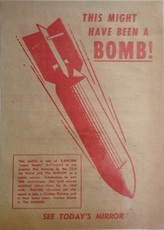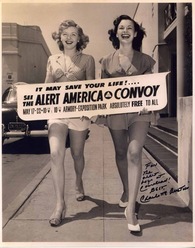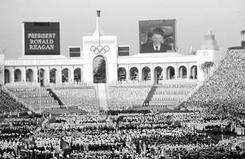The Cold War: L.A. Timeline
Although most of this site focuses on the relationship between the physical and imaginary remnants of the Cold War, there are several events, which occurred in- and outside of Los Angeles that are directly related to national and international politics surrounding the Cold War. Some aspects may still exist elsewhere, others only in their lasting effects, and some remain in the city, but their relationship to the Cold War is becoming a forgotten aspect of their history. This short timeline is an attempt to represent the fleeting memory of moments in Los Angeles' Cold War history. To learn more, click on the images or links.
The "Hollywood Blacklist" (1940s to the 1960's)
 The Hollywood Ten and their families
The Hollywood Ten and their families
Resulting from events throughout the late 1930s, and the House Un-American Activities (HUAC) hearings of the late 1940s, the "Hollywood Blacklist" combined a the anxiety of "The Red Scare" with industry-wide measures to cleanse the film and radio industries of Communist influence. The blacklist successfully banned many from working, ruining careers of those refusing to "name names". Beginning with "The Hollywood Ten", the list would grow to hundreds as private groups took on the charge of identifying those suspected of Communist sympathies. It wasn't until decades later in the 1960s that the practice ended, but the effects would last for some time. (Read More...)
The "Atom Bomb Dancers": Sexuality and the Bomb (August 6th, 1945- ?)

Although there has been a long-standing association between female sexuality and destructive power throughout mythological stories, in the 20th century, common references to women, such as calling them “bombshells”, which had been around since the 1930s, took on even greater significance with the advent of the atomic bomb. The introduction of the atomic age seemed to immediately carry with it a heightened sense of sexuality, and in turn magnify the relationship between destructive and sexual forces. Only two days after the bombing of Hiroshima, the Burbank Burlesque Theatre in Los Angeles invited readers to come see the “Atom Bomb Dancers”. but it was only the beginning of the bomb's allure. (Read more...)
San Fernando Valley Goat Association's "Memorial Service" (July 21st, 1946)

Operation Crossroads was a series of nuclear weapon tests that were the first nuclear weapon tests since Trinity (July 1945), and the first detonations of nuclear devices since the atomic bombing of Nagasaki (August 9, 1945). The first of many nuclear tests held in the Marshall Islands, the purpose the Crossroads operation was to investigate the effect of nuclear weapons on a fleet of 95 target ships. Assembled in Bikini Atoll Lagoon, the fleet was hit with two (ABLE and BAKER) detonations of plutonium implosion-type nuclear weapons. Both test incorporated animals to test the effects of exposure to the bomb and the resulting radiation. In an article reprinted by multiple newspapers, the San Fernando Valley Goat Association announced a memorial service for the goats that died as a result of these tests. (Read More...)
The "Atomic" Sunrise over Los Angeles

Between October 1951 through September 1992, 928 atomic tests were conducted at the Nevada Test Site, located Northwest of Las Vegas, only about 300 miles away from Los Angeles. Even at such a distance, many of these tests were completed above ground and, in the early morning hours, managed to give Los Angeles an “early sunrise”. With an energy output equated to 35,000 tons of TNT (or more) the tremendous explosion caused the sky over the city to fill with a glow that became a back-light to the buildings and mountain ranges of the city. (Read More...)
"Operation Wake-up": The Mock Bombing of L.A. (December 6th, 1951)

On the “eve of the Pearl Harbor anniversary”, thirty-eight planes of the Civil Air Patrol “bombed” Los Angeles. In a publicity stunt that was coordinated along with The Los Angeles Mirror, an afternoon tabloid launched by the L.A. Times, the CAP planes flew over the city, and began dropping 2,000,000 leaflets that read "THIS MIGHT HAVE BEEN A BOMB!". The leaflets posed the question, “If the Civil Air Patrol, flying this warning mission in co-operation with The Mirror, had been the enemy, would YOU have been prepared?” An obvious attempt at increasing paper sales, the two organizations excused the spectacle by questioning the alertness of Angelenos. (Read more...)
The "Alert America! Convoy" Comes to Los Angeles (May 17th-22nd, 1952)
 Merry Anders and Charlotte Austin
Merry Anders and Charlotte Austin
The Alert America Convoy was a national traveling exhibit designed to highlight the consequences of an atomic attack on American cities. Stops included both urban and rural cities, where parades, military exercises, air raid siren tests, mutual aid exercises, and even mock air raids were performed by the Air National Guard. The objective was to both shock and educate the public on "self-help" and community roles through joining the Civil Defense program. It was free and open to the public in Los Angeles' Exposition Park. (Read More...)
"Atoms for Peace" Mobile Exhibits (1957-1958)
|
In moving from full secrecy to public disclosure, the U.S. Atomic Energy Commission, along with the Museum of Atomic Energy, created the "Atoms for Peace" mobile campaign, which exhibited the safe applications of the atom in the shadow of Hiroshima and Nagasaki. Spreading the word across the nation in mobile vans, the exhibits included "Man from Mars" and "Mechanical Hands". Displays were set up at the Orange County Fair and at the National Orange Show in San Bernardino, as well as in Van Nuys and Long Beach. (Read More...)
|
Operation Alert (July 12th, 1957)

Between 1954 and 1961, the Federal Civil Defense Administration staged "Operation Alert" in cities across the country, testing the effectiveness of urban evacuation of officials and the public. Instead of being an educational event, however, it proved to be more theatrical, serving as a crucial component to Cold War pageantry footage for local and international media. “Operation Alert” took place in Los Angeles, on July 12, 1957 at 1:11pm, leaving an imaginary “one million ‘casualties’” across the state. (Read More...)
The Soviet National Exhibition at The Los Angeles Convention Center (November 12th-29th, 1977)

Over a period of 18 days in November of 1977 (12th-29th), 310,000 people attended the Soviet National Convention at the Los Angeles Convention Center. It was one of several exhibitions arranged between the U.S. and Soviet Union meant to increase understanding between the two countries, like its predecessors, the Los Angeles version ended up becoming another avenue for venting Cold War animosity, and presenting nationalistic propaganda. The Soviet Exhibition in Los Angeles was the largest Soviet scientific, social and technological exhibition ever staged in the United States. (Read More...)
The 1984 Los Angeles Olympics (July 28th-August 12th) & The Friendship Games (July 2nd-September 16th)

In the history of Cold War politics, the Olympic games were often a place where either country could prove the superiority of their ideologies. Few think of the 1984 Olympics in Los Angeles as a "Cold War" event, but it was in fact part of a greater scheme of competition between the two superpowers. (Read More...)
The Community Redevelopment Agency's "Daffodil Metamorphosis" (1996)

From WWII and into the Cold War period, approximately 200 air raid sirens were constructed in Los Angeles County. During the early 1980s, the sirens were decommissioned, but due to the high cost to remove them, were not dismantled. "Daffodil Metamorphosis," commissioned by a $20,000 grant from the Downtown Cultural Trust Fund of the Community Redevelopment Agency, was Michael Tansey's transformation of one of the sirens into a yellow daffodil as a public art project. Tansey felt that the metamorphosis created "a humorous and uplifting image" of Los Angeles, while serving as a gateway marker to the South Park area of downtown. (Read More...)
Know of any other events that should be included in the Timeline? Contact Us and let us know!

